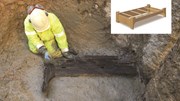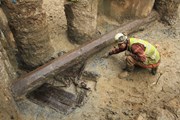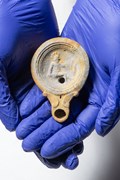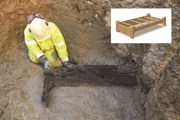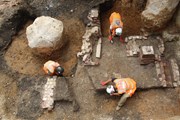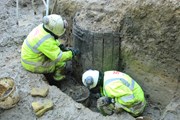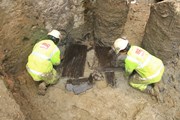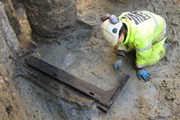
05 Feb 2024
First complete Roman funerary bed among extraordinary new archaeological discoveries in central London
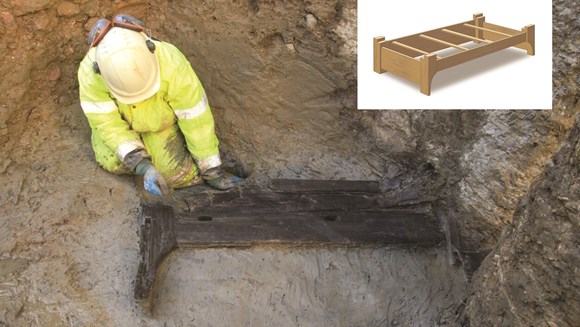
- Excavations at a site near Holborn Viaduct by MOLA have uncovered five rare Roman oak coffins and possibly the first complete Roman funerary bed found in Britain.
- As well as containing a Roman cemetery, the site covers an incredible 2000 years of London’s history.
- Other finds from the site include timber wells, thought to be part of a medieval tanning workshop.
Archaeological excavations near Holborn Viaduct in central London have revealed an extraordinary array of Roman (AD 43-410) finds, including wooden coffins and what appears to be a funerary bed. Excavations on the site have been taking place by MOLA (Museum of London Archaeology) ahead of the construction of 265,000 sq. ft office scheme developed by Royal London Asset Management Property. Now six metres below modern street level, the team have uncovered the resting place of some of Roman London’s first residents.
Preserved by the damp mud of the River Fleet, the oak coffins, and funerary bed, dating back almost 2000 years, are incredibly rare finds. Only three well-preserved Roman timber coffins have ever previously been found in London. Here archaeologists have already uncovered a further five.
Depictions of beds being used as part of funerals are common across the Roman world. However, the funerary bed found at this site is the first complete example ever discovered in Britain. Made from high-quality oak, the bed has carved feet, and joints fixed with small wooden pegs. It was dismantled prior to being placed within the grave but may have been used to carry the individual to the burial and was likely intended as a grave good for use in the afterlife.
Alongside skeletal remains, archaeologists have found personal objects including beads, a glass vial, and a decorated lamp – which is thought to date to the very early Roman period in Britain c. AD 48-80. Other artefacts accompanying burials in the Roman cemetery include high-status jewellery with jet and amber beads.
Heather Knight, Project Officer at MOLA explains: “We know the Romans buried their dead alongside roads, outside of urban centres. So, it was no great surprise to discover burials at this site, which during the Roman period would have been located 170m west of the city walls and next to the major Roman road of Watling Street. However, the levels of preservation we’ve encountered – and particularly uncovering such a vast array of wooden finds – has really blown us away.”
These Roman finds are just the latest layer to be revealed in the site’s slice through London’s history. Archaeologists discovered chalk floors and timber-lined wells, thought to be the remains of a 13th century tannery. Further wooden finds included a large 15th- or 16th-century water-pipe, which appears to have originally been used to pump water on a ship.
Excavations have also revealed there was another cemetery on the site during the 16th century, thought to be related to nearby St Sepulchre's church. After the devastation of the Great Fire of London in 1666, the site saw new life with the construction of houses, shops, and a pub, which were eventually replaced by Victorian warehouses. In the latest chapter, the site is currently being transformed into bespoke office space for global law firm Hogan Lovells.
While the MOLA team are continuing their excavations through early 2024, post-excavation work is also beginning to carefully conserve and analyse the finds from the site. These will reveal many new details about the people who lived, worked, and were buried here over the past 2000 years.
Excavations on this site have been taking place as part of the regeneration of the area, including the new office building for Hogan Lovells that will sit at the intersection of Holborn Viaduct and Farringdon Street. It is intended to display some of the archaeological finds at the property, adding to the cultural offer at a key gateway to the Culture Mile.
Keith Miller, Head of Offices at Royal London Asset Management Property said: “Holborn Viaduct has always been an exciting project for us as we contribute to the regeneration of the area by developing a sustainable office building that significantly enhances the broader public realm. We did not expect a find on this scale or of this significance. Royal London is committed to celebrating the heritage of all our projects, and it is remarkable that MOLA have unearthed so many important artefacts, shedding light on the details of our predecessors' lives.”
Hogan Lovells’ UK Managing Partner, Penny Angell, said “Hogan Lovells has a long and proud heritage on Holborn Viaduct, and we are fascinated to learn we are part of this significant archaeological discovery on the site of our new London office, Viaduct House. We are looking forward to seeing what new stories emerge about life here on this historical site that borders the River Fleet, based on MOLA’s findings.”
Chairman of the City of London Corporation Planning and Transport Committee, Shravan Joshi, said: “On behalf of the City Corporation, I’d like to thank everyone involved with the Holborn Viaduct excavation, for their careful and dedicated work uncovering these breathtaking artifacts. I look forward to the day these will be on display for the public to enjoy. The Square Mile has a uniquely diverse setting, with areas of great historical importance and beautiful heritage assets, alongside impressive skyscrapers, new hospitality venues, as well as residential homes across several estates. We will continue to enhance this offering and deliver a visitor destination for everyone to enjoy.”
Contact Information
Lily Hawker-Yates
Communications Officer
MOLA (Museum of London Archaeology)
07590879076
lhawkeryates@mola.org.uk
Notes to editors
Notes to editors.
Timeline:
- AD 43: The Romans invade Britain, led by Emperor Claudius. Burials begin at the site.
- c. AD 410: The end of the Roman period in Britain, the cemetery falls out of use.
- c.1200s: possible medieval tanning workshop
- c. 1500s: site used as extra-mural cemetery for nearby St Sepulchre’s Church
- c. 1600-1800: inn and housing built
- 1863-9: construction of Holborn Viaduct
- c. 1850-1900: construction of warehouses, which replace the earlier inns and houses
About MOLA:
MOLA is an experienced and innovative archaeological and built heritage practice, Independent Research Organisation, and charity. With over 350 staff working across England, MOLA has been providing independent, professional heritage advice and services for over 50 years. Find out more at mola.org.uk, on Twitter, Facebook and LinkedIn.
About Royal London Asset Management:
Royal London Asset Management is a key player in the UK commercial property market, operating across six key sectors: offices, retail, industrial and logistics, residential, healthcare and alternatives. The team is part of Royal London Asset Management, one of the UK's leading fund management companies, providing investment management solutions to both wholesale and institutional clients such as not-for-profit organisations, local authorities and the insurance sector. Visit rlam.com/uk to learn more.
About Hogan Lovells:
Operating at the intersection of business and government, global law firm Hogan Lovells has a deep understanding of and works together with clients to solve the toughest legal issues in major industry sectors and commercial centers around the world. Whether expanding into new markets, considering capital from new sources, or dealing with increasingly complex regulation or disputes, Hogan Lovells’ collaborative, straight talking and practical problem-solving approach helps clients to stay on top of risks, opportunities and disruption. Find out more at hoganlovells.com/en
About City of London Corporation:
The City of London Corporation is the governing body of the Square Mile dedicated to a vibrant and thriving City, supporting a diverse and sustainable London within a globally successful UK. Find out more at cityoflondon.gov.uk
About MOLA
MOLA is an experienced and innovative archaeological and built heritage practice, Independent Research Organisation, and charity. With over 350 staff working across England, MOLA has been providing independent, professional heritage advice and services for over 50 years. Find out more at mola.org.uk, on Twitter, Facebook and LinkedIn.
